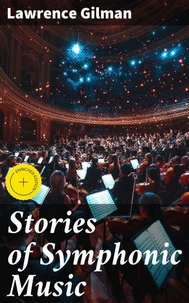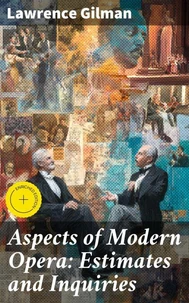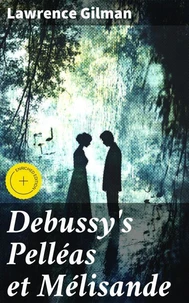Debussy's Pelléas et Mélisande. A Guide to the Opera with Musical Examples from the Score
Par :Formats :
Disponible dans votre compte client Decitre ou Furet du Nord dès validation de votre commande. Le format ePub est :
- Compatible avec une lecture sur My Vivlio (smartphone, tablette, ordinateur)
- Compatible avec une lecture sur liseuses Vivlio
- Pour les liseuses autres que Vivlio, vous devez utiliser le logiciel Adobe Digital Edition. Non compatible avec la lecture sur les liseuses Kindle, Remarkable et Sony
 , qui est-ce ?
, qui est-ce ?Notre partenaire de plateforme de lecture numérique où vous retrouverez l'ensemble de vos ebooks gratuitement
Pour en savoir plus sur nos ebooks, consultez notre aide en ligne ici
- Nombre de pages55
- FormatePub
- ISBN859-65--4724071-6
- EAN8596547240716
- Date de parution04/09/2022
- Protection num.Digital Watermarking
- Taille910 Ko
- Infos supplémentairesepub
- ÉditeurDIGICAT
Résumé
In "Debussy's Pelléas et Mélisande, " Lawrence Gilman conducts a profound exploration of Claude Debussy's groundbreaking opera, a work that marked a radical departure from traditional operatic forms and aesthetics. Gilman's literary analysis delves into the intricate interplay of music and symbolism embedded within Debussy's score, as well as the deeper thematic currents of love, loss, and existential longing that permeate Maurice Maeterlinck's original play.
Employing a rich, evocative style, Gilman situates the opera in its historical context, highlighting the influence of Impressionism and the transformative cultural landscapes of early 20th-century Europe, which shaped Debussy's innovative compositional techniques and narrative approach. Lawrence Gilman (1866-1916) was an American music critic and writer whose passion for music was evident in his keen insights and eloquent prose.
His extensive exposure to European art music and the burgeoning modernist movement positioned him uniquely to appreciate the subtleties of Debussy's work. Gilman's intellectual pursuits, particularly his engagement with the philosophies of aesthetics and modernism, resonated with Debussy's vision, compelling him to articulate the significance of the opera in both a musical and cultural framework. For readers interested in musicology, opera, or Impressionist art, Gilman's treatise is indispensable.
It not only enriches the understanding of Debussy's "Pelléas et Mélisande, " but also serves as a poignant reminder of the opera's enduring legacy. Scholars and casual readers alike will find Gilman's insights illuminating, making this text a cornerstone for appreciating Debussy's complex artistic persona.
Employing a rich, evocative style, Gilman situates the opera in its historical context, highlighting the influence of Impressionism and the transformative cultural landscapes of early 20th-century Europe, which shaped Debussy's innovative compositional techniques and narrative approach. Lawrence Gilman (1866-1916) was an American music critic and writer whose passion for music was evident in his keen insights and eloquent prose.
His extensive exposure to European art music and the burgeoning modernist movement positioned him uniquely to appreciate the subtleties of Debussy's work. Gilman's intellectual pursuits, particularly his engagement with the philosophies of aesthetics and modernism, resonated with Debussy's vision, compelling him to articulate the significance of the opera in both a musical and cultural framework. For readers interested in musicology, opera, or Impressionist art, Gilman's treatise is indispensable.
It not only enriches the understanding of Debussy's "Pelléas et Mélisande, " but also serves as a poignant reminder of the opera's enduring legacy. Scholars and casual readers alike will find Gilman's insights illuminating, making this text a cornerstone for appreciating Debussy's complex artistic persona.
In "Debussy's Pelléas et Mélisande, " Lawrence Gilman conducts a profound exploration of Claude Debussy's groundbreaking opera, a work that marked a radical departure from traditional operatic forms and aesthetics. Gilman's literary analysis delves into the intricate interplay of music and symbolism embedded within Debussy's score, as well as the deeper thematic currents of love, loss, and existential longing that permeate Maurice Maeterlinck's original play.
Employing a rich, evocative style, Gilman situates the opera in its historical context, highlighting the influence of Impressionism and the transformative cultural landscapes of early 20th-century Europe, which shaped Debussy's innovative compositional techniques and narrative approach. Lawrence Gilman (1866-1916) was an American music critic and writer whose passion for music was evident in his keen insights and eloquent prose.
His extensive exposure to European art music and the burgeoning modernist movement positioned him uniquely to appreciate the subtleties of Debussy's work. Gilman's intellectual pursuits, particularly his engagement with the philosophies of aesthetics and modernism, resonated with Debussy's vision, compelling him to articulate the significance of the opera in both a musical and cultural framework. For readers interested in musicology, opera, or Impressionist art, Gilman's treatise is indispensable.
It not only enriches the understanding of Debussy's "Pelléas et Mélisande, " but also serves as a poignant reminder of the opera's enduring legacy. Scholars and casual readers alike will find Gilman's insights illuminating, making this text a cornerstone for appreciating Debussy's complex artistic persona.
Employing a rich, evocative style, Gilman situates the opera in its historical context, highlighting the influence of Impressionism and the transformative cultural landscapes of early 20th-century Europe, which shaped Debussy's innovative compositional techniques and narrative approach. Lawrence Gilman (1866-1916) was an American music critic and writer whose passion for music was evident in his keen insights and eloquent prose.
His extensive exposure to European art music and the burgeoning modernist movement positioned him uniquely to appreciate the subtleties of Debussy's work. Gilman's intellectual pursuits, particularly his engagement with the philosophies of aesthetics and modernism, resonated with Debussy's vision, compelling him to articulate the significance of the opera in both a musical and cultural framework. For readers interested in musicology, opera, or Impressionist art, Gilman's treatise is indispensable.
It not only enriches the understanding of Debussy's "Pelléas et Mélisande, " but also serves as a poignant reminder of the opera's enduring legacy. Scholars and casual readers alike will find Gilman's insights illuminating, making this text a cornerstone for appreciating Debussy's complex artistic persona.





